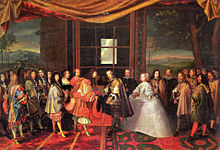The two goats

The two goats (French: Les Deux Chèvres ) is the fourth fable in the twelfth book of the collection of fables Fables Choisies, Mises En Vers by the French fabulous poet Jean de La Fontaine . The source probably lies with Pliny the Elder .
At first glance, the fable seems to be a banal story of two goats who meet head-on in the middle of a narrow footbridge over a stream. Since neither of the goats wants to go back to let the other go first, they fight each other and eventually both fall into the water. Through a series of rapidly changing images, the fabulist reveals a multiple transformation process of the protagonists - the transformation of goats into humans and back again. La Fontaine gives the constant impression that it is women and not goats in order to hide the comparison of kings with animals.
interpretation
With reference to their grazing , the poet states at the outset that goats are animals and when their bellies are full they indulge in foolish behavior. Immediately after the first sentence, La Fontaine compares her to women, but adventurous women: a certain sense of freedom makes them seek their happiness, they go on a journey, with esprit de liberté their reluctance to be confined to their pasture is shown. Esprit also implies wit and intelligence. Through indirect language and in cycles, the poet uses images of nature (a rock, a mountain with threatening cliffs) to refer to two sophisticated women who are aware of their picturesque beauties, but who show their blasé boredom through their repellent nature. The image of the goats as society ladies is already implicitly present before the poet uses the term dames . The play on words in caprices (German: Kaprize , derived from the Latin word for goat, "capres") reminds us that they are goats; it points to their arbitrariness and the wanton folly that will lead to their discomfort at the end of the poem .

While the two goats move towards each other, the animal portrait is maintained by "patte blanche" (white hoof), a common distinguishing feature in fables and generally in fairy tales. When they reach the stream, the goats become "Amazons". The Amazons, however, were intrepid hunters and riders, so that the balancing of the goats on the plank becomes a visual parody. The human image now takes over completely: the goats are now "people" and - far from having "white hooves" - they put "one foot" on the jetty. The fact that the goats were just being described as Amazons was probably a satirical allusion to one of the most colorful personalities at court, Mademoiselle de Montpensier , la Grande Mademoiselle. She was known as 'Amazone de la Fronde' along with her two friends, the Duchess of Longueville and the Duchess of Chevreuse . La Grande Mademoiselle caused a scandal at the king's wedding: she insisted on being present at the wedding, and when permission was refused, she disguised herself as a peasant girl and came along anyway. They soon betrayed their haughty manners.
The next passage contains the only documented image in the poem: the already human protagonists become men, the kings of France and Spain. The meeting of the two goats on a plank is likened to a famous ceremony that took place between the two kings in 1660. The meeting in the Pavillon de la Conference on the Île des Faisans was intended to confirm the marriage of Louis XIV to Maria Theresa, daughter of Philip IV . The comparison takes place on several levels: the caution of the two animals makes the progress seem stately in its slowness - the two kings advanced with a similarly measured step, so that neither should reach the ceremonial table first to sign the marriage contract. Finally, there is a possible political dimension to this parallel. Although the relationship between Louis and Philip was fairly cordial in 1660, it deteriorated around 1691. When Les deux Chevres first appeared, the two nations faced each other in the War of the Spanish Succession. The reason the goats in this fable move so slowly and carefully is because a stream flows below them: one wrong step and they could fall into it. This is one of La Fontaine's several covert attacks on Louis XIV's aggressive foreign policy.
Individual evidence
- ^ Jean de La Fontaine : Fables Choisies, Mises En Vers. In: Landesbibliothek Oldenburg . P. 79 , accessed on March 29, 2020 (French).
- ^ Ernst Dohm (translator): Lafontaine's fables. In: Badische Landesbibliothek . Retrieved March 29, 2020 .
- ^ A b c Slater, Maya: The craft of La Fontaine . Fairleigh Dickinson University Press, Cranbury, NJ, USA 2001, ISBN 0-8386-3920-8 , pp. 50-56 .